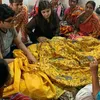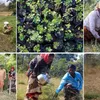Recognition, rejuvenation, resilience - how these MayinArt artists evolve their approach to creativity
The pandemic has been tough commercially for many artists, but has also given them time to reflect, practice and evolve. Here are highlights and insights from three artists.
Launched in 2014, PhotoSparks is a weekly feature from YourStory, with photographs that celebrate the spirit of creativity and innovation. In the earlier 535 posts, we featured an art festival, cartoon gallery. world music festival, telecom expo, millets fair, climate change expo, wildlife conference, startup festival, Diwali rangoli, and jazz festival.
Founded by Krish Datta and Avik Bandyopadhyay, Singapore-based MayinArt is a digital platform to showcase Indian and Southeast Asian art. Images of some of these artworks have been reprinted in this article series with permission from MayinArt.
See our extended coverage here, with pictorial highlights and artist insights. The artworks are priced from a few hundred dollars up to around $3,000.
“Art is very visual. Slowly, with digital trust and online visualisation techniques improving, people have started to rely on the virtual medium for viewing and appreciating art,” Avik Bandyopadhyay explains in a chat with YourStory.
“Online art purchase is still in its nascency. We have a long and wide path to go,” he adds, while also expressing optimism about the future of online exhibitions, global outreach potential, and sales.

Ranger Primates by Nanang Sato
Nanang Sato
“Art is a medium for expression of the soul. Success for me comes from pride and self-satisfaction, especially when my work is appreciated by others. That itself is one of the greatest achievements and awards,” explains Indonesian artist Nanang Sato.
Sales are also important – especially for an artist who is dedicated only to painting, without having another job, he adds.
“The style of my painting depicts animal figures with realistic techniques in surrealistic nuances, starting from the love and admiration for animals I have had since childhood,” Nanang describes.
In addition to observing and admiring their physical forms and behaviours, he always feels compassion for endangered animals. “Their status is now increasingly threatened with extinction due to natural damage as well as illegal hunting and illegal trades,” he laments.
“Animals are one of the important elements in the chain of natural life. Humans, animals and plants need each other,” Nanang affirms.
He depicts animal figures combined with robotic elements, such as the addition of a mechanical arm or leg. “This is a figurative meaning of maintaining its shape and sustaining its life from extinction due to hunting and habitat destruction,” Nanang says.
His work explores new ideas, shapes and imagery. “I continue to work as usual during this pandemic. Maybe it's because painting is my life, so I keep making art in any situation,” he adds.
“Continue to work. Always explore your potential as well as insights and abilities, all of which must go through a long process of development,” he advises aspiring artists.

Misty by Rashmi Soni
Rashmi Soni
“Art is meditation for me. Art means being with myself and a spiritual means to connect with the superpower,” explains Indian contemporary artist Rashmi Soni.
“I get lost when I practice art. It rejuvenates me and protects me from all the negativity,” she adds. She sees success in recognition and getting commissioned works.
“When students say they are willing to learn your techniques, that definitely gives you satisfaction as an artist,” Rashmi enthuses. She is also Karnataka State Head for the International Watercolour Society.
She describes her style as semi-realistic. “I always keep the light and shadow correct and give loose strokes. The style evolves with the practice. The more you practice and produce works, the more people will recognise you,” she describes.
The pandemic has been a difficult time artists, while also giving them more time to reflect and create. “Commercially, it might be tough, but as an artist, it has given me more opportunity to meditate and practice, and produce more artworks,” Rashmi says.
She also offers tips for aspiring artists. “Practice more, and practice every day. Increase control over the pencil, that will give you the strength to work on any media,” she suggests.
“Do not copy the work of other artists. Produce your own work that will give you recognition and fame,” she adds.
“Meditate more, and be patient. Once you are ready, no one can stop you from getting established as an artist,” Rashmi sums up.

Against the wave, follow the wind by Nugroho Heri Cahyono
Nugroho Heri Cahyono
“Art for me is a way of expressing myself, taking a stand, and conveying ideas using the language of visual arts,” explains Indonesian artist Nugroho Heri Cahyono. He is an art lecturer at Yogyakarta, and was a finalist on the UOB Painting of The Year competition in 2012.
He sees success in recognition and impact. “Success comes from appreciation and being able to provide motivation and hope to society, in bringing out the values of humanism – or making humanism great again,” he adds.
He describes his art style as contemporary. “I am heavily influenced and inspired by current conditions such as urban culture, identity, and modernisation. Over time, my work combines traditions and cultures that are increasingly being forgotten and are disappearing – such as folklore and myths,” Nugroho describes.
The pandemic is having a huge impact on every sector, including the arts. “But this has actually made my work more mature, since I have plenty of time for observation and experimentation with ideas and techniques,” he observes.
“This pandemic also made me learn from the lifestyle of people in rural areas – forest and mountain dwellers, for example. I learn about their spirit, courage, independence, and togetherness while living a hard life,” Nugroho explains.
He also offers words of advice for aspiring artists. “My only message is: keep working, and don't be easily satisfied with what you've done. Hone your sensitivity in creating art. Keep the spirit up,” Nugroho signs off.
Now, what have you done today to find new avenues to harness your creative core?

Little girl with rose by Sabar Jambul

diary no 1 by Suryadi Suyamtina

COURTYARD OF MEMORIES’ 12th by Santhosh Deepak Andrade

Dance of the wind #1 by Ramadhyan Putri Pertiwi

fitfully #1 by Triana P

forest #7 by Refijon

Mother Mary - Neo Aeon Series by Rangga RJP

On mind and soul by Wage E S

path by Riki Antoni

polution#4 by Husin

Provoke-VIII by Supriya Polley

Thirsty Earth by Rudragaud L Indi

vintage 3 By Shrea Ghosh

visitor #1 by Nugroho Heri Cahyono

Women in Crowd the by Ruchika KC

Heading Home #2 by Rashmi Soni

Threat by Nanang Sato
See also the YourStory pocketbook ‘Proverbs and Quotes for Entrepreneurs: A World of Inspiration for Startups,’ accessible as apps for Apple and Android devices.
Edited by Kanishk Singh










